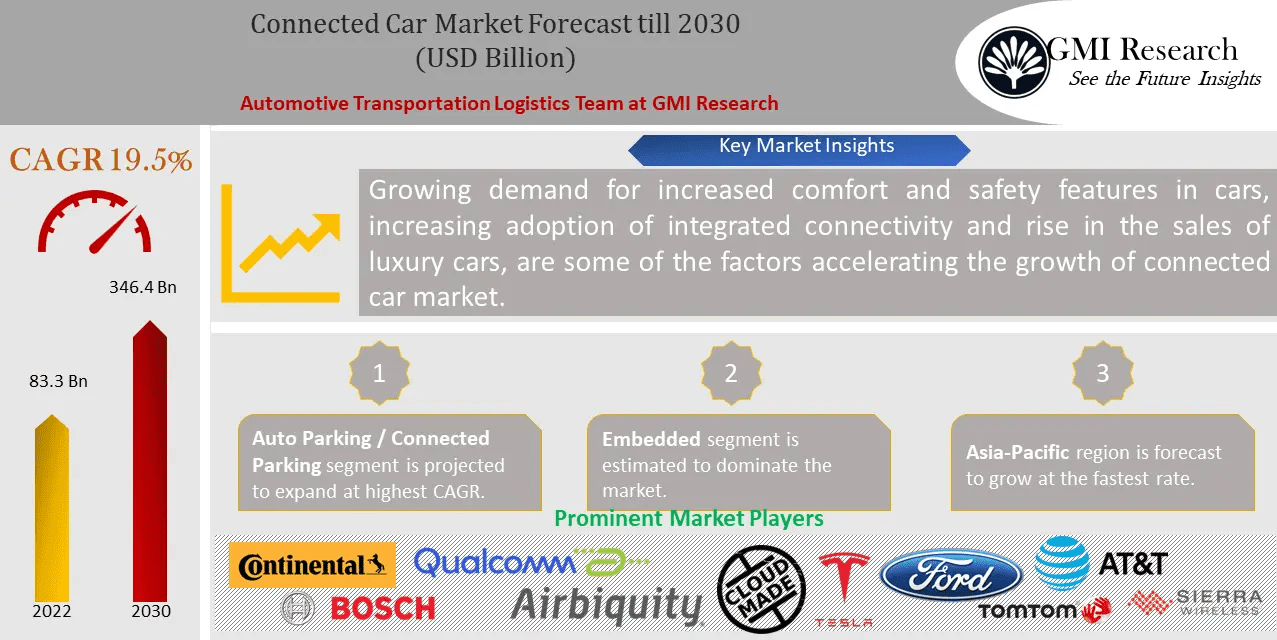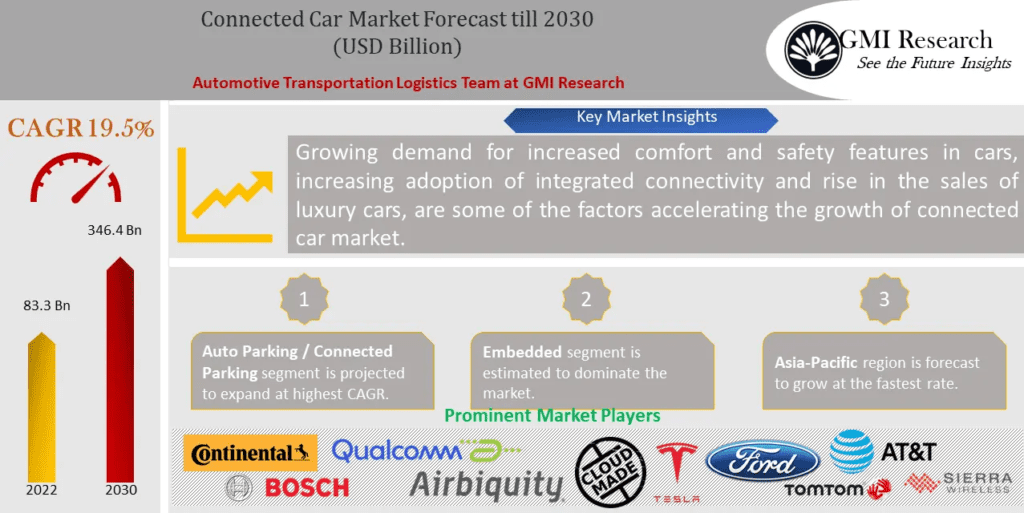Connected Cars: Powering the Future of Intelligent Mobility

Digitalization has transformed the automotive sector by not only developing road safety but also decreasing costs significantly. The connected car stands out as a prime example of how the industry has embraced the era of connectivity, carrying vital significance to both businesses and drivers alike. The widespread deployment of mobile networks has made connectivity an integral part of our daily lives, reaching different unpredicted areas. In the mobility sector, connectivity has specifically stood out, offering significant potential in terms of developing road safety, promoting environmental sustainability, and cost savings.
Table of Contents
ToggleConnected Car
A connected car denotes a vehicle with internet admittance, allowing the transmission and reception of data. Improvements such as 5G networks and the Internet of Things (IoT) have played an influential role in expanding connectivity in roads, cities, and numerous vehicle types. The objective is to change cars into connected devices capable of continuous communication with their environment through the web.
In addition, internet connectivity has become a standard feature in modern automobiles, often installed at the factory by producers. For older vehicles lacking built-in connectivity, which still constitute most roads, communication with the outside world can be established either through smartphone devices, a common method, or by utilizing devices installed directly in the car via the OBD port.
Market Size
The global connected car market growth and size was anticipated at USD 83.3 billion in 2022 and is projected to register a double-digit CAGR of 19.5% in the forecast period of 2023-2030 and is anticipated to reach USD 346.4 billion in 2030.
Several Variety of in-car connectivity
The connectivity options in vehicles vary based on the technology integrated. Certain car producers initiated connectivity with Wi-Fi admittance, later progressing to 4G and 5G network offerings. Notably, the US and China are pursuing distinct connectivity strategies from Europe, aiming at the deployment of next-generation mobile networks, indicating regional differences in approach.
Smartphones have become broadly used for connectivity in vehicles owing to their familiarity and versatility. They enable features like map navigation, route planning reliant on real-time traffic, and weather conditions, and mobile geolocation utilities. In addition, smartphones seamlessly connect to 4G and 5G networks, relying on the device and network capabilities in the car’s location. The extensive deployment of these networks not only develops smartphone functionality but also confirms a reliable and present service for users.
Devices that adapt to cars and use Wi-Fi connections are often plugged in and controlled through dedicated smartphone apps, ensuring a user-friendly experience. This seamless integration enables convenient control and admittance, developing the complete ease of usage for customers.
The real-time data collected through installed sensors or devices in vehicles can be communicated to other devices utilizing different types of connectivity such as Wi-Fi, Bluetooth, or 4G and 5G networks. This data empowers drivers to make informed decisions, delivering warnings about nearby pedestrians, unpredicted lane changes, or the necessity for maintenance, developing complete safety and driving experiences.
Quick Read – Web-Based Entertainment: Social Media and Student Success
Benefits of Connected Car
Decreasing the number of accidents, saving lives, cutting costs, and safeguarding the environment are the foremost benefits of connected cars. The evolution of technology, starting from the first e-Call roadside emergency systems and Emergency Crash Warning Systems, has proficiently improved, developing efforts to save lives and develop road safety.
The report titled ‘Sustainable Mobility of the Future and its Impact on the SDGs’ organized by Mobility City, discovers that the 51 million connected vehicles presently on the road have the potential to save 11,000 lives and prevent 260,000 accidents annually. This substantial impact helps in eradicating both the financial and personal losses caused by accidents.
Certainly, sustainability is developed through data sharing in different manners. Drivers can access information about their driving behavior, enabling them to develop habits and avoid traffic congestion. Cities can encourage sustainable mobility by delivering multi-modal mobility options, such as information about free parking spaces and bus schedules, which decreases CO2 emissions from cars. This approach also propels optimized mobility, positively impacting sectors such as logistics.
Future Forecast of the Connected Car
The deployment of the 5G networks is allowing a significant rise in connected cars in the connected car market. The accomplishment of connected automobiles is propelling their production forward, propelled by the positive impacts of digitalization in fields such as sustainable mobility, electrification, and autonomous driving. This growth reflects the transformation influence of improved technology in the automotive industry.
It is essential to distinguish between connected cars and autonomous cars. Connected cars use internet connectivity to facilitate decision-making by the driver, demanding their intervention. In contrast, autonomous cars can make decisions automatically through the application of AI, eradicating the requirement for constant driver intervention. These are distinct concepts, each with its level of automation and capabilities.
The technology in the automotive sector is developing speedily, introducing innovative tools such as eye tracking, and facial recognition. These tools not only develop safety by detecting driver fatigue but also include approaches reliant on eye tracking, and sensors to monitor heart rate. The automotive industry endures to propel the advancement of new functionalities, presenting its role as a powerful catalyst for technological innovation.
The future of connected cars is closely intertwined with the concept of Smart Cities. Technologies such as Big Data, AI, and IoT will inevitably merge in these contexts. These innovations will seamlessly connect cars with urban elements such as zebra crossing, traffic lights, and others ushering in a new era of integrated and intelligent transportation systems within urban surroundings.

11 Social Media Content Types That Captivate in 2024

Top Artificial intelligence Blogs Websites To Follow in 2024

5 Types of Social Media Networks and Their Benefits

Top Artificial intelligence Blogs Websites To Follow in 2024

Connected Cars: Powering the Future of Intelligent Mobility

11 Social Media Content Types That Captivate in 2024

Top Artificial intelligence Blogs Websites To Follow in 2024

5 Types of Social Media Networks and Their Benefits







